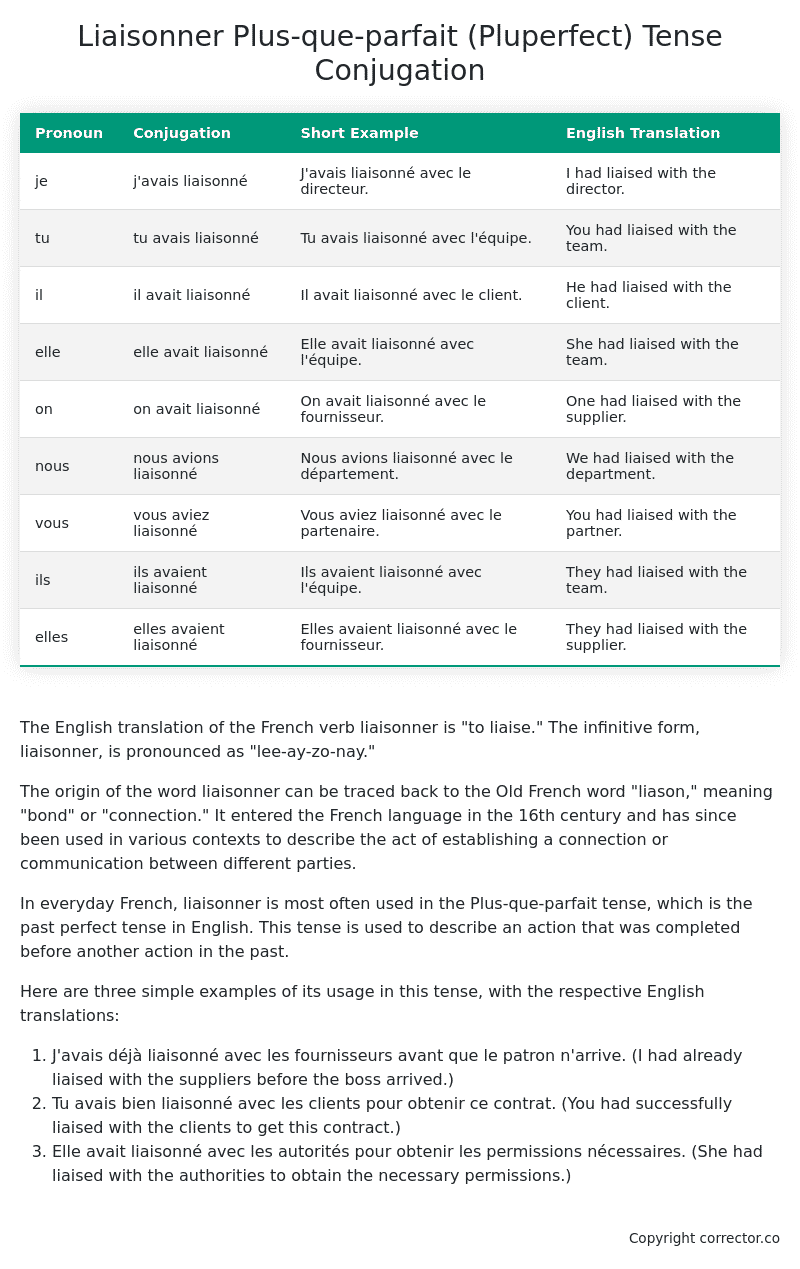Plus-que-parfait (Pluperfect) Tense Conjugation of the French Verb liaisonner
Introduction to the verb liaisonner
The English translation of the French verb liaisonner is “to liaise.” The infinitive form, liaisonner, is pronounced as “lee-ay-zo-nay.”
The origin of the word liaisonner can be traced back to the Old French word “liason,” meaning “bond” or “connection.” It entered the French language in the 16th century and has since been used in various contexts to describe the act of establishing a connection or communication between different parties.
In everyday French, liaisonner is most often used in the Plus-que-parfait tense, which is the past perfect tense in English. This tense is used to describe an action that was completed before another action in the past.
Here are three simple examples of its usage in this tense, with the respective English translations:
- J’avais déjà liaisonné avec les fournisseurs avant que le patron n’arrive. (I had already liaised with the suppliers before the boss arrived.)
- Tu avais bien liaisonné avec les clients pour obtenir ce contrat. (You had successfully liaised with the clients to get this contract.)
- Elle avait liaisonné avec les autorités pour obtenir les permissions nécessaires. (She had liaised with the authorities to obtain the necessary permissions.)
Table of the Plus-que-parfait (Pluperfect) Tense Conjugation of liaisonner
| Pronoun | Conjugation | Short Example | English Translation |
|---|---|---|---|
| je | j’avais liaisonné | J’avais liaisonné avec le directeur. | I had liaised with the director. |
| tu | tu avais liaisonné | Tu avais liaisonné avec l’équipe. | You had liaised with the team. |
| il | il avait liaisonné | Il avait liaisonné avec le client. | He had liaised with the client. |
| elle | elle avait liaisonné | Elle avait liaisonné avec l’équipe. | She had liaised with the team. |
| on | on avait liaisonné | On avait liaisonné avec le fournisseur. | One had liaised with the supplier. |
| nous | nous avions liaisonné | Nous avions liaisonné avec le département. | We had liaised with the department. |
| vous | vous aviez liaisonné | Vous aviez liaisonné avec le partenaire. | You had liaised with the partner. |
| ils | ils avaient liaisonné | Ils avaient liaisonné avec l’équipe. | They had liaised with the team. |
| elles | elles avaient liaisonné | Elles avaient liaisonné avec le fournisseur. | They had liaised with the supplier. |
Other Conjugations for Liaisonner.
Le Present (Present Tense) Conjugation of the French Verb liaisonner
Imparfait (Imperfect) Tense Conjugation of the French Verb liaisonner
Passé Simple (Simple Past) Tense Conjugation of the French Verb liaisonner
Passé Composé (Present Perfect) Tense Conjugation of the French Verb liaisonner
Futur Simple (Simple Future) Tense Conjugation of the French Verb liaisonner
Futur Proche (Near Future) Tense Conjugation of the French Verb liaisonner
Plus-que-parfait (Pluperfect) Tense Conjugation of the French Verb liaisonner (this article)
Passé Antérieur (Past Anterior) Tense Conjugation of the French Verb liaisonner
Futur Antérieur (Future Anterior) Tense Conjugation of the French Verb liaisonner
Subjonctif Présent (Subjunctive Present) Tense Conjugation of the French Verb liaisonner
Subjonctif Passé (Subjunctive Past) Tense Conjugation of the French Verb liaisonner
Subjonctif Imparfait (Subjunctive Imperfect) Tense Conjugation of the French Verb liaisonner
Subjonctif Plus-que-parfait (Subjunctive Pluperfect) Tense Conjugation of the French Verb liaisonner
Conditionnel Présent (Conditional Present) Tense Conjugation of the French Verb liaisonner
Conditionnel Passé (Conditional Past) Tense Conjugation of the French Verb liaisonner
L’impératif Présent (Imperative Present) Tense Conjugation of the French Verb liaisonner
L’infinitif Présent (Infinitive Present) Tense Conjugation of the French Verb liaisonner
Struggling with French verbs or the language in general? Why not use our free French Grammar Checker – no registration required!
Get a FREE Download Study Sheet of this Conjugation 🔥
Simply right click the image below, click “save image” and get your free reference for the liaisonner Plus-que-parfait tense conjugation!

Liaisonner – About the French Plus-que-parfait (Pluperfect) Tense
Tense Formation
Common everyday usage patterns
Sequencing of past events
Background information
Hypothetical or reported speech
Interactions with other tenses
Summary
I hope you enjoyed this article on the verb liaisonner. Still in a learning mood? Check out another TOTALLY random French verb conjugation!


